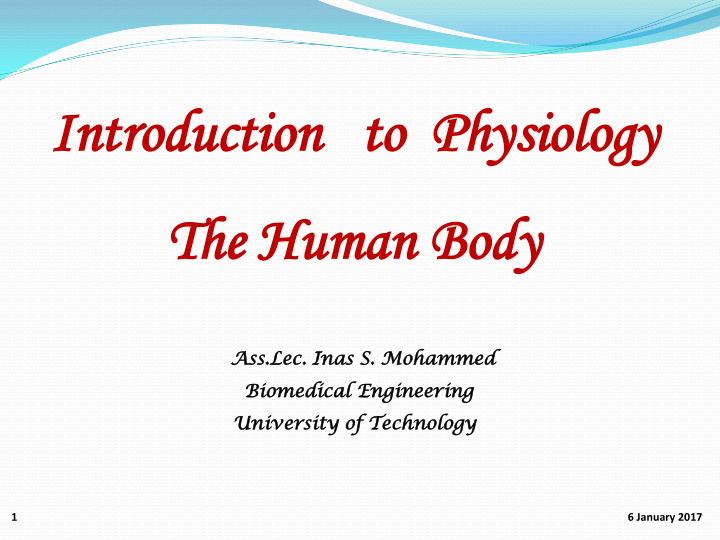



In Intr troduction oduction t to P o Phy hysiology siology Th The e Hu Huma man n Bo Body dy Ass. s.Le Lec. . Inas S. Mohammed med Bi Biomedi medical Engineering cal Engineering Universit Un sity y of Techno nolog logy 1 6 January 2017
Introduction roduction 1- phy physiolog iology The he wor ord phy physiolog iology is is from om the Ancient the Ancient Greek, eek, and and it is it is the the study tudy of of ho how organis or ganisms ms perf perfor orm m their their vital ital functions unctions. . An An example xample is is the the study tudy of of ho how a a mus muscle le con contr tract acts or or the the for orce ce con contr tract acting ing mu muscles les exer ert t on on the the skele eleton ton. . Phy hysiolo iology is is bui built lt upon a tri upon a tripod of pod of s sciences ciences: phys : physics ics, c , chemistr hemistry, and ana , and anatomy tomy. . 2-Human physiology is the study of the mechanical, physical, and biochemical processes that support the body's function. 6 January 2017 2
Introduction roduction 3- Approximately 60% of the human body is fluid • Two thirds of the fluid is retained within cells – Intracellular • Intracellular fluid contains large amounts of potassium, magnesium, and phosphate ions. • One third of the fluid is outside cells – Extracellular • Extracellular fluid contains large amounts of sodium, chloride, and bicarbonate ions as well as nutrients including oxygen, glucose, fatty acids, and amino acids . 3 6 January 2017
Introd roduction uction Types es of human physiol iology Human physiology is the study of functions of the human body that can be divided into the following types:. 1- Cell physiology it is the study of the functions of cells. 2- Special physiology This is the study of the functions of special organs. For example, renal physiology is the study of kidney function. 3- Systemic physiology It includes all aspects of the function of the body systems, such as cardiovascular physiology, respiratory physiology, reproductive physiology etc.. 4- Pathophysiology It is the study of the effects of diseases on organ or system functions . 6 January 2017 4
Introd roduction uction Level el of of or organi nization zation Different levels of organization a- Atom: An atom is the smallest particle of an element [carbon (C), Hydrogen (H), Oxygen (O), etc.]. b- Molecule: A molecule is a particle composed of two or more joined atoms (carbon dioxide CO2, water H2O). C- Macromolecule: A macromolecule is a large molecule (carbohydrates, lipids, proteins, nucleic acids) . 6 January 2017 5
Defin inati ation ons Organelles: An organelle is a small organ of a cell, which performs a particular function (cell membrane, cytoplasm and nucleus) 1- Cell: The cell is the basic unit of structure and function of living organisms. 2- Tissue: A tissue is a group of similar cells that performs a specialized function (epithelia, connective, muscle and nervous). 3- Organ: An organ is a structure consisting of a group of tissues that perform a specialized function (skin, heart, brain, etc…). 4- System: A system is a group of organs that act together to perform a specialized function. a. cardiovascular system, b. respiratory system, c. urinary system, d. digestive system, e. nervous system, f. respiratory system, g. endocrine system, h. musculoskeletal system, i. integument system. 5- Human body: A living organism is the most complex level of organization. It consists of all the systems. 6 January 2017 6
Introd roduction uction The e sev even en charac racte teris ristics tics of life 1- Cell: All living organisms have cells; cells are the building blocks of life. 2- Metabolism: All living organisms eat, drink, breathe and excrete. 3- Growth: All living organisms take in material from the environment to enlarge and sustain. 4- Reproduction: All living organisms are able to produce a copy of themselves. 5- Irritability: All living organisms are able to react to a change in their environment. 6- Adaptation: All living organisms are able to compete with each other for food and space to survive. 7- Movement: All living organisms are able to move. 6 January 2017 7
The En The End 6 January 2017 8
Recommend
More recommend